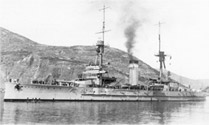 When the Spanish Civil War broke out in July 1936, the situation in the Cantabrian Sea (the Spanish name for the Bay of Biscay) was clearly favourable to the insurgents. The battleship España, the cruiser Almirante Cervera, the destroyer Velasco and other smaller vessels were seized in El Ferrol. Various vessels under construction were also seized. These included the cruisers Canarias and Baleares, which would soon to come into service, and four minelayers scheduled to be ready later, of which only one, the Jupiter, came into service before Bilbao fell.
When the Spanish Civil War broke out in July 1936, the situation in the Cantabrian Sea (the Spanish name for the Bay of Biscay) was clearly favourable to the insurgents. The battleship España, the cruiser Almirante Cervera, the destroyer Velasco and other smaller vessels were seized in El Ferrol. Various vessels under construction were also seized. These included the cruisers Canarias and Baleares, which would soon to come into service, and four minelayers scheduled to be ready later, of which only one, the Jupiter, came into service before Bilbao fell.
Only the small Torpedero 3, based in Pasajes, remained loyal to the Republic. In October 1936, after the Republican Fleet’s expedition to the North, the destroyer José Luis Diez and submarines C-2 and C-5 remained in the Bay of Biscay. They were used to set up the Cantabrian Sea Naval Forces. The C-5 was lost in December and the destroyer Císcar and submarines C-4 and C-6 were added in spring 1937. This naval force was not noted for its outstanding performance, particularly, when the majority of its officers sympathised with the insurgents. They used their positions to sabotage the vessels and to foster demoralisation and indiscipline among the crew.
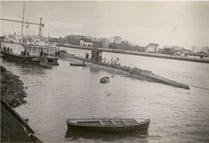 The naval superiority of the rebels meant that they operated unchallenged during the first months of the war. They bombed the coast, seizing or sinking various merchant vessels and they prevented any fishing from taking place. The poor performance of the Republican vessels and the need to insure sea communications forced the Basque Government to set up its own naval force to cover these tasks.
The naval superiority of the rebels meant that they operated unchallenged during the first months of the war. They bombed the coast, seizing or sinking various merchant vessels and they prevented any fishing from taking place. The poor performance of the Republican vessels and the need to insure sea communications forced the Basque Government to set up its own naval force to cover these tasks.
On 15th October 1936, the head of the Basque Government and Basque Minister of Defence, José Antonio de Agirre, appointed Joaquín de Egia and Untzueta, head of the Navy Division, who took over ten days later. This Division was entrusted with the mission to organize an auxiliary naval force of the Republican Army, which would protect merchant maritime traffic and the fishing its own waters and keep the access to the Basque ports free of underwater mines. That was the beginning of the Auxiliary Navy of the Basque Country (1936-37)
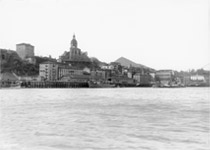 The Section Headquarters were in the third floor of Bilbao’s Hotel Carton. They were initially rather reduced in size, as they were limited to the officer in charge, a secretary, a radio operator and the administrative staff. The Auxiliary Fleet soon increased in size to the point that the Headquarters needed a larger structure, which was achieved in March 1937. The organization as such was kept in place until the fall of Bilbao. When the headquarters were moved to Bilbao, the structure was reduced to the section head with his secretary, an engine inspector, an administrative officer, a supplies officer and a small number of auxiliary staff. During the war, its organisation could be broken down as follows:
The Section Headquarters were in the third floor of Bilbao’s Hotel Carton. They were initially rather reduced in size, as they were limited to the officer in charge, a secretary, a radio operator and the administrative staff. The Auxiliary Fleet soon increased in size to the point that the Headquarters needed a larger structure, which was achieved in March 1937. The organization as such was kept in place until the fall of Bilbao. When the headquarters were moved to Bilbao, the structure was reduced to the section head with his secretary, an engine inspector, an administrative officer, a supplies officer and a small number of auxiliary staff. During the war, its organisation could be broken down as follows:
- Navy Section Headquarters: It was directly in charge of the operational management of the Auxiliary Navy vessels and services. Responsibility for these services was distributed between various divisions:
- Secretariat: It was in charge of the secretariat, information and documentation, archives, health tasks…
- Personnel and Weapons Division: In charge of recruiting personnel, postings, billeting, armaments,…
- Construction and Repairs Division: In charge of overseeing any modifications and repairs made to the Auxiliary Navy vessels.
- Administration Division: In charge of accounting and the cashier’s office.
- Transmissions Division: In charge of radio-telegraphic and radio communications.
- Quartermaster Division: In charge of supplies and storage of provisions, military and naval supplies.
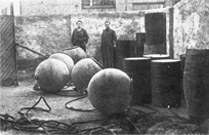 Portugalete Navy Delegation: The Delegation was based in the Portuagelete hotel from November 1936 and also had a provisions and quartermaster's warehouse on the dockside, along with a warehouse fitted out to store the underwater mines that were recovered. The Delegation supervised the Portugalete port installations which was the base for all the Auxiliary Navy vessels, as well as being a linked with the armed trawlers and overseeing the coastal surveillance and mine recovery services. It also had various small boats available for port tasks.
Portugalete Navy Delegation: The Delegation was based in the Portuagelete hotel from November 1936 and also had a provisions and quartermaster's warehouse on the dockside, along with a warehouse fitted out to store the underwater mines that were recovered. The Delegation supervised the Portugalete port installations which was the base for all the Auxiliary Navy vessels, as well as being a linked with the armed trawlers and overseeing the coastal surveillance and mine recovery services. It also had various small boats available for port tasks. - Atalayas and Watchtower Department: All the vantage points and watchtowers were under and directly reported any developments to Navy Headquarters. It was set up to ensure coastal surveillance from fixed structures at Punta Lucero, Punta Galea, Sopelana, Plencia, Cabo Villano, Cabo Machichaco and Lequeitio.
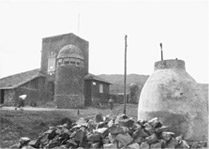 Harbourmaster Department: Between November 1936 and March 1937, Navy Headquarters was also in charge of Bilbao Port's Harbourmaster's Office. It was transferred to the Merchant Navy Directorate that March.
Harbourmaster Department: Between November 1936 and March 1937, Navy Headquarters was also in charge of Bilbao Port's Harbourmaster's Office. It was transferred to the Merchant Navy Directorate that March.- Navy Barracks:: Later on in 1937, Navy Barracks were set up in Guecho to house the ranks waiting for their postings or in reserve to crew the vessels that were being provisioned. The commander of the trawler Araba was in charge, as its crew formed the majority of the barrack's garrison.
- Armed trawlers: They depended directly on the Navy Headquarters and were not organised in a flotilla. However, the oldest officer, who occasionally acted as commodore, was the commander of the Gipuzkoa, Manuel Galdós. On 5th August 1937, the active trawlers were transferred to the Cantabrian Sea Naval Forces.
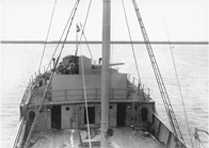 Minesweeping Flotilla: The Portugalete Delegation were in charge of the day-to-day planning and coordinating of the division, following the instructions of the Navy Headquarters, while a captain was appointed to be directly in command. It included the minesweepers and the motorboats that worked with them. On 1st August 1937, six minesweepers and two auxiliary motorboats were transferred to the Cantabrian Sea Naval Forces and the remainder was evacuated to France a month later.
Minesweeping Flotilla: The Portugalete Delegation were in charge of the day-to-day planning and coordinating of the division, following the instructions of the Navy Headquarters, while a captain was appointed to be directly in command. It included the minesweepers and the motorboats that worked with them. On 1st August 1937, six minesweepers and two auxiliary motorboats were transferred to the Cantabrian Sea Naval Forces and the remainder was evacuated to France a month later.- Special Services: The Navy Headquarters sent personnel and some vessels on special missions, such as the radio and radio telegraphic link with Bayonne, the maritime link with the same town and, even, supplying weapons and provisions to the loyal ports along the Biscay coast. The vessels from these services would remain in France when Bilbao fell.
- Personnel in the Cantabrian Sea Naval Forces: A dozen of clerks and drivers on loan from the Auxiliary Navy worked in the Cantabrian Sea Naval Forces' offices, which were also located in the Hotel Carlton. In addition, in May 1937, 9 petty officers and sailors of the Sea Volunteers were posted to the C-6 submarine, at the request of its commander, to replace other crew members who were under suspicion or to cover casualties.
 At the beginning of June, at the request of the Cantabrian Sea Naval Forces, the majority of the crew of the José Luis Díez and Císcar destroyers were disembarked as they were considered insubordinate and untrustworthy. Two hundred and ten sailors from the Sea Volunteers were sent to replace them. From then and until the fall of Bilbao, the two destroyers and the submarine were supplied by the Quartermaster's Services of the Basque Country Navy Headquarters. Once the vessels were transferred to Santander, a good number of them were disembarked and the remainder joined to the Republican Navy.
At the beginning of June, at the request of the Cantabrian Sea Naval Forces, the majority of the crew of the José Luis Díez and Císcar destroyers were disembarked as they were considered insubordinate and untrustworthy. Two hundred and ten sailors from the Sea Volunteers were sent to replace them. From then and until the fall of Bilbao, the two destroyers and the submarine were supplied by the Quartermaster's Services of the Basque Country Navy Headquarters. Once the vessels were transferred to Santander, a good number of them were disembarked and the remainder joined to the Republican Navy.
